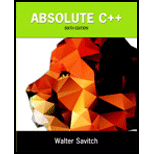
The game of Pig is a simple two player dice game in which the first player to reach 100 or more points wins. Players take turns. On each turn a player rolls a six-sided die:
- If the player rolls a 2-6 then he or she can either
— ROLL AGAIN or
— HOLD. At this point the sum of all rolls made this turn is added to the player’s total score and it becomes the other player’s turn.
- If the player rolls a 1 then the player loses his or her turn. The player gets no new points and it becomes the opponent’s turn.
If a player reaches 100 or more points after holding then the player wins.
Write a
int humanTurn (int humanTota1Score) ;
int computerTurn ( int computerTota1Score) ;
These functions should perform the necessary logic to handle a single turn for either the computer or the human. The input parameter is the total score for the human or computer. The functions should return the turn total to be added to the total score upon completion of the turn. For example, if the human rolls a 3 and 6 and then holds, then humanTurn should return 9. However, if the human rolls a 3 and 6 and then a 1, then the function should return 0.
Want to see the full answer?
Check out a sample textbook solution
Chapter 3 Solutions
Absolute C++
Additional Engineering Textbook Solutions
Thinking Like an Engineer: An Active Learning Approach (4th Edition)
Modern Database Management
Java: An Introduction to Problem Solving and Programming (8th Edition)
BASIC BIOMECHANICS
Starting Out with Java: From Control Structures through Objects (7th Edition) (What's New in Computer Science)
Starting Out with C++ from Control Structures to Objects (9th Edition)
 EBK JAVA PROGRAMMINGComputer ScienceISBN:9781337671385Author:FARRELLPublisher:CENGAGE LEARNING - CONSIGNMENT
EBK JAVA PROGRAMMINGComputer ScienceISBN:9781337671385Author:FARRELLPublisher:CENGAGE LEARNING - CONSIGNMENT Operations Research : Applications and AlgorithmsComputer ScienceISBN:9780534380588Author:Wayne L. WinstonPublisher:Brooks Cole
Operations Research : Applications and AlgorithmsComputer ScienceISBN:9780534380588Author:Wayne L. WinstonPublisher:Brooks Cole Microsoft Visual C#Computer ScienceISBN:9781337102100Author:Joyce, Farrell.Publisher:Cengage Learning,
Microsoft Visual C#Computer ScienceISBN:9781337102100Author:Joyce, Farrell.Publisher:Cengage Learning, C++ for Engineers and ScientistsComputer ScienceISBN:9781133187844Author:Bronson, Gary J.Publisher:Course Technology Ptr
C++ for Engineers and ScientistsComputer ScienceISBN:9781133187844Author:Bronson, Gary J.Publisher:Course Technology Ptr EBK JAVA PROGRAMMINGComputer ScienceISBN:9781305480537Author:FARRELLPublisher:CENGAGE LEARNING - CONSIGNMENTProgramming Logic & Design ComprehensiveComputer ScienceISBN:9781337669405Author:FARRELLPublisher:Cengage
EBK JAVA PROGRAMMINGComputer ScienceISBN:9781305480537Author:FARRELLPublisher:CENGAGE LEARNING - CONSIGNMENTProgramming Logic & Design ComprehensiveComputer ScienceISBN:9781337669405Author:FARRELLPublisher:Cengage





